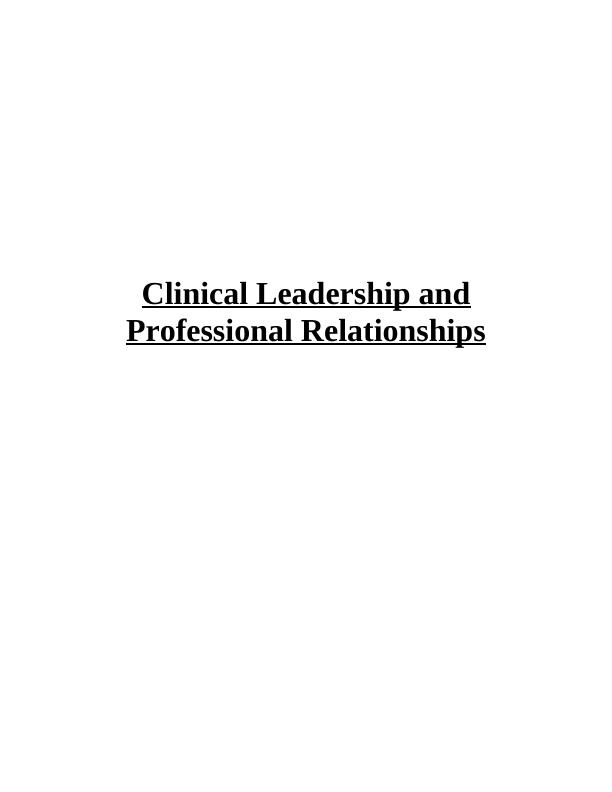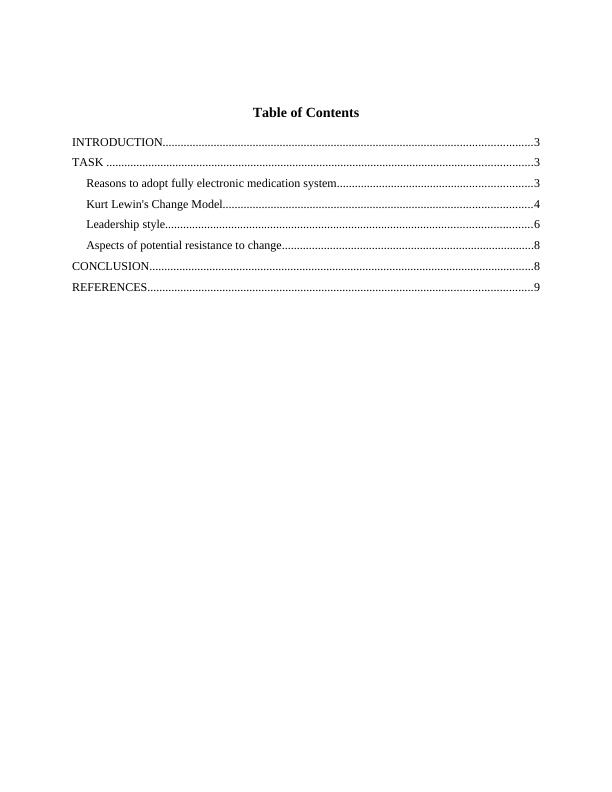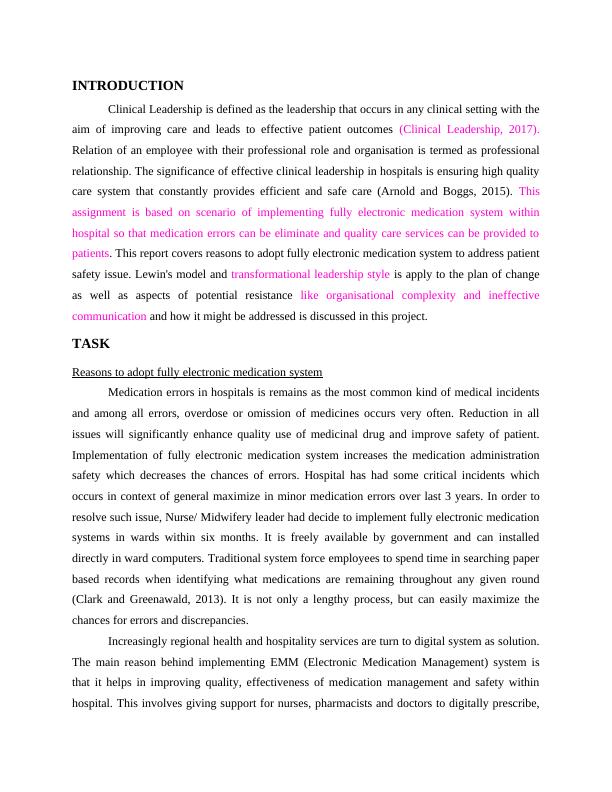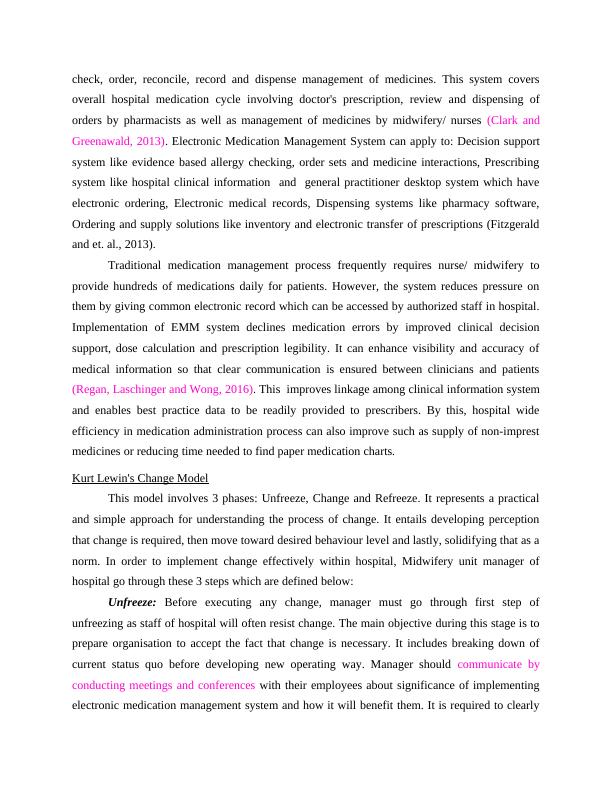Ask a question from expert
Clinical Leadership and Professional Relationships Assignment
11 Pages3260 Words130 Views
Added on 2021-01-02
Clinical Leadership and Professional Relationships Assignment
Added on 2021-01-02
BookmarkShareRelated Documents
Clinical Leadership andProfessional Relationships

Table of ContentsINTRODUCTION...........................................................................................................................3TASK ..............................................................................................................................................3Reasons to adopt fully electronic medication system.................................................................3Kurt Lewin's Change Model.......................................................................................................4Leadership style..........................................................................................................................6Aspects of potential resistance to change....................................................................................8CONCLUSION................................................................................................................................8REFERENCES................................................................................................................................9

INTRODUCTIONClinical Leadership is defined as the leadership that occurs in any clinical setting with theaim of improving care and leads to effective patient outcomes (Clinical Leadership, 2017).Relation of an employee with their professional role and organisation is termed as professionalrelationship. The significance of effective clinical leadership in hospitals is ensuring high qualitycare system that constantly provides efficient and safe care (Arnold and Boggs, 2015). Thisassignment is based on scenario of implementing fully electronic medication system withinhospital so that medication errors can be eliminate and quality care services can be provided topatients. This report covers reasons to adopt fully electronic medication system to address patientsafety issue. Lewin's model and transformational leadership style is apply to the plan of changeas well as aspects of potential resistance like organisational complexity and ineffectivecommunication and how it might be addressed is discussed in this project. TASK Reasons to adopt fully electronic medication systemMedication errors in hospitals is remains as the most common kind of medical incidentsand among all errors, overdose or omission of medicines occurs very often. Reduction in allissues will significantly enhance quality use of medicinal drug and improve safety of patient.Implementation of fully electronic medication system increases the medication administrationsafety which decreases the chances of errors. Hospital has had some critical incidents whichoccurs in context of general maximize in minor medication errors over last 3 years. In order toresolve such issue, Nurse/ Midwifery leader had decide to implement fully electronic medicationsystems in wards within six months. It is freely available by government and can installeddirectly in ward computers. Traditional system force employees to spend time in searching paperbased records when identifying what medications are remaining throughout any given round(Clark and Greenawald, 2013). It is not only a lengthy process, but can easily maximize thechances for errors and discrepancies. Increasingly regional health and hospitality services are turn to digital system as solution.The main reason behind implementing EMM (Electronic Medication Management) system isthat it helps in improving quality, effectiveness of medication management and safety withinhospital. This involves giving support for nurses, pharmacists and doctors to digitally prescribe,

check, order, reconcile, record and dispense management of medicines. This system coversoverall hospital medication cycle involving doctor's prescription, review and dispensing oforders by pharmacists as well as management of medicines by midwifery/ nurses (Clark andGreenawald, 2013). Electronic Medication Management System can apply to: Decision supportsystem like evidence based allergy checking, order sets and medicine interactions, Prescribingsystem like hospital clinical information and general practitioner desktop system which haveelectronic ordering, Electronic medical records, Dispensing systems like pharmacy software,Ordering and supply solutions like inventory and electronic transfer of prescriptions (Fitzgeraldand et. al., 2013). Traditional medication management process frequently requires nurse/ midwifery toprovide hundreds of medications daily for patients. However, the system reduces pressure onthem by giving common electronic record which can be accessed by authorized staff in hospital.Implementation of EMM system declines medication errors by improved clinical decisionsupport, dose calculation and prescription legibility. It can enhance visibility and accuracy ofmedical information so that clear communication is ensured between clinicians and patients(Regan, Laschinger and Wong, 2016). This improves linkage among clinical information systemand enables best practice data to be readily provided to prescribers. By this, hospital wideefficiency in medication administration process can also improve such as supply of non-imprestmedicines or reducing time needed to find paper medication charts. Kurt Lewin's Change ModelThis model involves 3 phases: Unfreeze, Change and Refreeze. It represents a practicaland simple approach for understanding the process of change. It entails developing perceptionthat change is required, then move toward desired behaviour level and lastly, solidifying that as anorm. In order to implement change effectively within hospital, Midwifery unit manager ofhospital go through these 3 steps which are defined below: Unfreeze: Before executing any change, manager must go through first step ofunfreezing as staff of hospital will often resist change. The main objective during this stage is toprepare organisation to accept the fact that change is necessary. It includes breaking down ofcurrent status quo before developing new operating way. Manager should communicate byconducting meetings and conferences with their employees about significance of implementingelectronic medication management system and how it will benefit them. It is required to clearly

End of preview
Want to access all the pages? Upload your documents or become a member.
Related Documents
Clinical Leadership in Nursing and Midwiferylg...
|7
|2167
|357
Nurse and Medication Safetylg...
|5
|1777
|351
Drug Dispensing Process: Role of Pharmacy Technicians in Ensuring Patient Safetylg...
|4
|1581
|212
Controls for Reducing Medication Errors in Healthcare Settingslg...
|4
|760
|329
Literature Review Assignment : Nursinglg...
|12
|3587
|31
Clinical Leadership and Professional Relationshiplg...
|9
|2315
|275